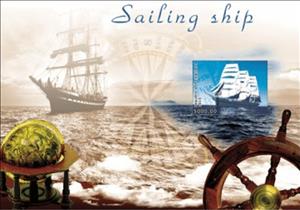Souvenir Sheet: Sailing Ships (Somaliland 2015)
Sailing Ships (Somaliland 2015)
01 January (Somaliland ) within release Sailing Ships (2015) goes into circulation Souvenir Sheet Sailing Ships face value 5,000 Somaliland shilling
| Souvenir Sheet Sailing Ships in catalogues | |
|---|---|
| Colnect codes: | Col: RS 2015-82 |
Souvenir Sheet is square format.
Genuine issued Somaliland stamps ended in 1960 when they gained their independence from being a British Protectorate and became part of Somalia. All stamps used for postage in Somaliland are Somalia stamps from July 1, 1960 forward. Somaliland has no authority to issue their own stamps and has no postal office since 1991 due to conflict with Somalia. This counterfeit is produced in Moscow, Russia and distributed by Russian and Eastern European counterfeit stamp dealers.Also in the issue Sailing Ships (2015):
- Souvenir Sheet - Sailing Ships face value 5,000;
- Souvenir Sheet - Sailing Ships face value 5,000;
- Souvenir Sheet - Sailing Ships face value 5,000;
- Souvenir Sheet - Sailing Ships face value 5,000;
- Souvenir Sheet - Sailing Ships face value 5,000;
- Souvenir Sheet - Sailing Ships face value 5,000;
- Souvenir Sheet - Sailing Ships face value 5,000;
- Souvenir Sheet - Sailing Ships face value 5,000;
- Souvenir Sheet - Sailing Ships face value 5,000;
- Souvenir Sheet - Sailing Ships face value 5,000;
- Souvenir Sheet - Sailing Ships face value 5,000;
- Souvenir Sheet - Sailing Ships face value 5,000;
- Souvenir Sheet - Sailing Ships face value 5,000;
- Souvenir Sheet - Sailing Ships face value 5,000;
- Souvenir Sheet - Sailing Ships face value 5,000;
|
Data entry completed
50%
|
|
|---|---|
| Souvenir Sheet Sailing Ships in digits | |
| Country: | Somaliland |
| Date: | 2015-01-01 |
| Emission: | Illegal |
| Format: | Souvenir Sheet |
| Face Value: | 5,000 Somaliland shilling |
Souvenir Sheet Sailing Ships it reflects the thematic directions:
A modern sailing ship or sailship is any large wind-powered vessel. Traditionally a sailing ship (or simply ship) is a sailing vessel that carries three or more masts with square sails on each. Large sailing vessels that are not ship-rigged may be more precisely referred to by their sail rig, such as schooner, barque (also spelled "bark"), brig, barkentine, brigantine or sloop. There are many different types of sailing ships, but they all have certain basic things in common. Every sailing ship has a hull, rigging and at least one mast to hold up the sails that use the wind to power the ship. The crew who sail a ship are called sailors or hands. They take turns to take the watch, the active managers of the ship and her performance for a period. Watches are traditionally four hours long. Some sailing ships use traditional ship's bells to tell the time and regulate the watch system, with the bell being rung once for every half hour into the watch and rung eight times at watch end (a four-hour watch). Ocean journeys by sailing ship can take many months, and a common hazard is becoming becalmed because of lack of wind, or being blown off course by severe storms or winds that do not allow progress in the desired direction. A severe storm could lead to shipwreck, and the loss of all hands. Sailing ships are limited in their maximum size compared to ships with heat engines, so economies of scale are also limited. The heaviest sailing ships (limited to those vessels for which sails were the primary means of propulsion) never exceeded 14,000 tons displacement. Sailing ships are therefore also very limited in the supply capacity of their holds, so they have to plan long voyages carefully to include many stops to take on provisions and, in the days before watermakers, fresh water.

